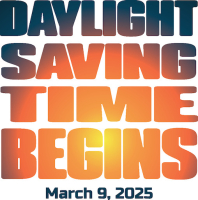Upcoming Events
![]()

IN Shearing School
The Indiana Sheep Association is hosting their annual Shearing School on Saturday, Feb. 22, 9 a.m.-4 p.m., at the Purdue University Sheep Unit, 5480 ASREC Lane, West Lafayette. For more information call 317-607-5664.
Webinar On Avian Influenza: Impact On Wild Birds and Human Health
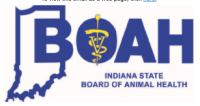
BOAH Quarterly Lunch-and-Learn
Thursday, February 27, 2025 at Noon (Eastern)
The Indiana State Board of Animal Health (BOAH) continues the quarterly lunch-and-learn webinar series with a second offering in February focused on highly pathogenic avian influenza (HPAI) away from the farm. BOAH's partners at Indiana Department of Health and Indiana Department of Natural Resources will join us to discuss human health issues and how the disease is impacting wild birds.
The one-hour session is offered free to the public via MS Teams. The webinar will be recorded and posted to BOAH’s YouTube channel at a later date.
Veterinarians and registered veterinary technicians who participate can earn 1 hour of continuing education credit.
Thursday, February 27 @ Noon Eastern
The Indiana State Board of Animal Health is hosting a second webinar this month to address HPAI-related issues beyond the farm to include helpful information from two of the agency’s state partners:
- Indiana Department of Natural Resources Fish and Wildlife Health Biologist Eli Fleace will share insights about how HPAI is impacting wild birds in Indiana and beyond.
- Indiana Department of Health’s Dr. Eric Hawkins, state epidemiologist, and Dr. Jennifer Brown, state public health veterinarian, will share information about what citizens should know about HPAI and human health.
Participants are invited to submit questions related to human health and/or wild birds before the webinar to:
To register:
https://events.gcc.teams.microsoft.com/event/b225db7a-29c7-4e0d-be8a-d3d8f56bffd9@2199bfba-a409-4f13-b0c4-18b45933d88d
Participants may register up to the start of the webinar,
but must allow time to receive the email with the access link.
Ag Outlook 2025
Free breakfast.
Featured topics:
"Grain and livestock market outlooks and factors impacting market trends"
"Supply/Demand relationship to input availability.
RSVP by Feb. 21 to Danielle Walker,
Campbellsburg Town Board
The Town of Campbellsburg schedules its Town Board meetings on the first Monday of each month, except for September.
The meetings begin at 6:30 p.m. and are held at the Campbellsburg Community Center, 21 West Oak Street, Campbellsburg.
Washington County Commissioners
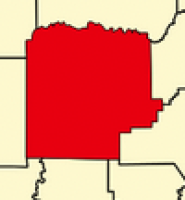
The Washington County Commissioners will meet the first and third Tuesday of each month, unless otherwise noted by schedule or by special legal notice.
Executive sessions will be held 7:30 a.m. to 9 a.m., with the open session beginning at 9 a.m.
The meetings will be held at the Washington County Courthouse, 99 Public Square, Suite 200, Salem, Indiana.
Any special meetings throughout the year will be advertised prior to the meeting time and date.
Cattlemen Annual Meeting
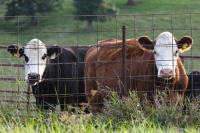
The Washington County Cattlemen's Association will host their Annual Meeting on Thursday, March 6, 2025 at Southern Hills Church, located on State Rd. 135 S. in Salem. The meeting will begin at 6:30 pm with a meal. Reservations are required by Monday, February 24 to Purdue Extension – Washington County at 812-8834601.
Anyone interested in the beef industry is invited to the annual meeting and to join the organization. Annual membership dues for the Washington County Cattlemen’s Association are $20 per household. Dues may be paid at the annual meeting or by contacting the Extension office. More information about the organization is found at https://extension.purdue.edu/county/washington/anr1/sub-page-anr.html.
AWC Chili Cook-Off
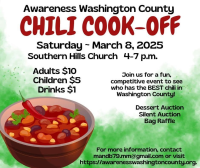
The Awareness Washington County Board announced that the 8th annual Chili Cook Off will be held Saturday, March 8, from 4-7 p.m., at Southern Hills Church,1645 Hwy. 135, Salem.
Competition is open to anyone interested, and cash prizes will be awarded in several categories. There will be a prize for the judged Best Red Chili, as well as the judged Best White Chili. In addition, there are People’s Choice awards for Best Chili and Best Decorated booth. Other features of the event are the famous dessert auctions and the cookie cart. There will also be items available in the Silent Auction and the Bag Raffle.
Admission to the event is $10 for adults and $5 for children. All-you-can-eat chili and crackers are included in the admission price, along with ballots to vote for your favorite chili and best decorated booth.
Sponsorships for the event are available as well. Sponsors will be recognized in the media, on the AWC website, on table tents at every table at the event, and on social media. There will be several hundred people attending.
Interested chili cooks can register by contacting Marji Morris on Facebook, by email at
“The event has become a social occasion,” said Morris. “Many people come at 4 p.m. and stay until the end to see who wins, although you don’t have to do that.” She continued, “Having a booth allows businesses to get themselves and their products or services in front of the public, just for the cost of their chili ingredients.” There will be a maximum of 12 teams so sign up soon, and guests can sample as many of the chilis as they can handle.
Rules for Chili Cook-off
- Prizes awarded for People’s Choice Best Chili, Best decorated booth, Judges’ choice best red chili and best white chili.
- Teams are to provide 3 crock pots (or equivalent) of the same chili.
- Typed list of major ingredients. (For those with food allergies--Exact recipe not required. You don’t have to give away your secrets.)
- Decorating limited to a 6 ft table space with 1 ft. additional space on both sides and 4ft. behind the table. Decorating is not required, but it is part of the fun. Tables are provided.
- Set up may begin at 10 a.m. Chili should be in place no later than 2:30 p.m. for judging. Teams may leave after set-up and return by 3:45 p.m.
- Collectively the team is allowed free admission for 2 adults and 2 kids. After that, tickets are adults $10/children $5.
- There is no entry fee, but we are limiting participation to 12 teams.
Bull Breeding Soundness Evaluation Clinic
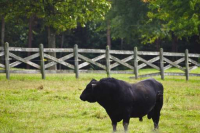
Evaluation of bulls for breeding soundness is one of the most neglected management practices of Indiana’s cattle producers. A bull is expected to breed 20 to 50 cows during the breeding season and too often his ability to do so is taken for granted.
The evaluation should be done prior to the breeding season. Breeding problems that are discovered at pregnancy checking occur far too late to prevent substantial loss of income. Breeders that sell bulls should have them evaluated prior to sale. Bull suppliers depend largely on repeat customers and selling an infertile bull may cost the breeder a good customer as well as create a lot of bad advertisement.
The breeding soundness evaluation cannot guarantee fertility but it is the best method available to predict which bulls will not settle cows. Approximately 10% of bulls will fail the Breeding Soundness Evaluation (BSE). The routine BSE will not detect bulls with low libido; therefore, observation of the bull in the breeding pasture is still important. Observe bulls to confirm they are finding and breeding cows that are in heat. Observe the same cows in three weeks to ensure they are bred.
The BSE includes an evaluation of structural soundness, evaluation of the reproductive anatomy and, most importantly, evaluation of semen quality. During the BSE, a semen sample is collected and evaluated immediately for percent motile sperm. Minimally, 30% of the sperm must be motile in order for the bull to pass the exam. The same sample is then stained and individual sperm are evaluated. Seventy percent of the cells must be normal microscopically for the bull to be an acceptable breeder.
The BSE Clinic scheduled for Washington County is Wednesday, March 12, 2025 in Salem. For reservations or more information, contact Danielle Walker at 812-883-4601 or
The evaluation charge is $50 per bull. Bulls must be at least one year old and weigh at least 900 pounds.
BSE Clinics are conducted annually through the joint cooperation of Washington County Cattlemen’s Association, Spring Mill Veterinary Service, and Purdue Extension – Washington County.
SalemLeader.com
Leader Publishing Company of Salem, Inc.
P.O. Box 506
117-119 East Walnut Street
Salem, Indiana. 47167
Phone: 812-883-3281 | Fax: 812-883-4446
Business Hours:
Mondays through Fridays, 9:00am - 5:00pm
News:
news@salemleader.com
Office:
office@salemleader.com
Publisher:
publisher@salemleader.com
Business
- More Business News
- Go To Guide
- Business Directory
- Auctions
Education
- More Education News
Opinion
- Editorials
- Letters to the Editor
- Columns
- Unsung Heroes
- Days Gone By
- In the Garden
- Guest Columns
- Reader's Poll
- Salem Leader Forum
- Questions and Answers
Church
- Bible Aerobics
- Church News
- Church Directory


